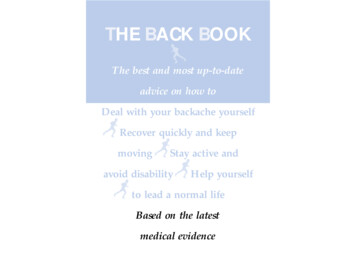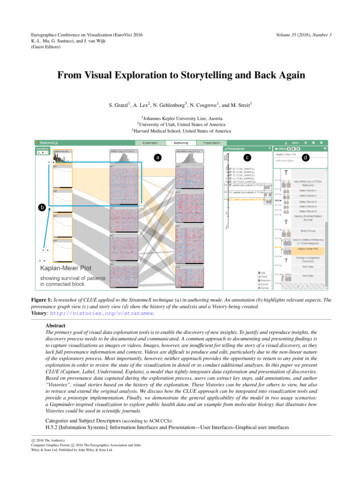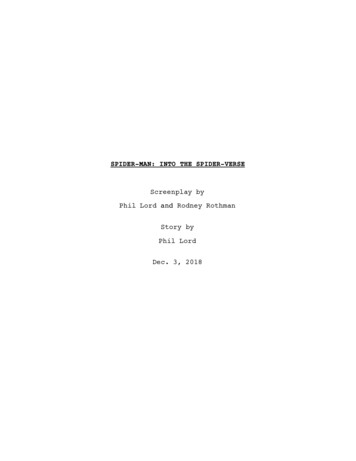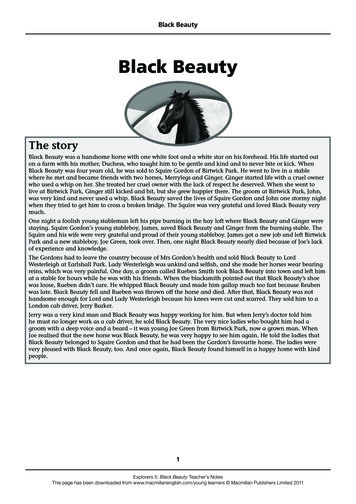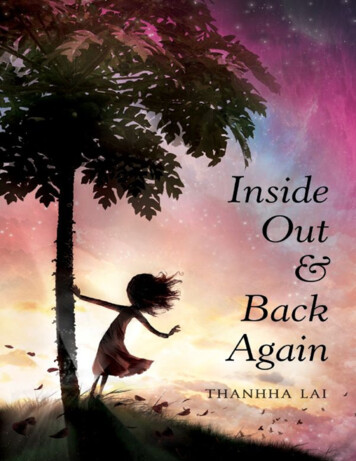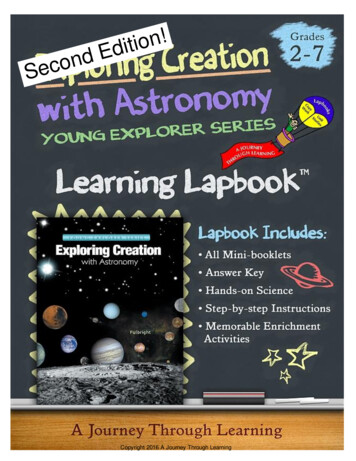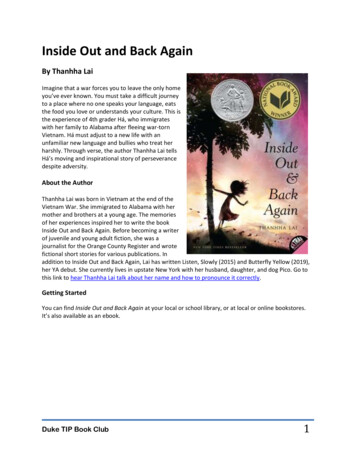
Transcription
Inside Out and Back AgainBy Thanhha LaiImagine that a war forces you to leave the only homeyou’ve ever known. You must take a difficult journeyto a place where no one speaks your language, eatsthe food you love or understands your culture. This isthe experience of 4th grader Há, who immigrateswith her family to Alabama after fleeing war-tornVietnam. Há must adjust to a new life with anunfamiliar new language and bullies who treat herharshly. Through verse, the author Thanhha Lai tellsHá’s moving and inspirational story of perseverancedespite adversity.About the AuthorThanhha Lai was born in Vietnam at the end of theVietnam War. She immigrated to Alabama with hermother and brothers at a young age. The memoriesof her experiences inspired her to write the bookInside Out and Back Again. Before becoming a writerof juvenile and young adult fiction, she was ajournalist for the Orange County Register and wrotefictional short stories for various publications. Inaddition to Inside Out and Back Again, Lai has written Listen, Slowly (2015) and Butterfly Yellow (2019),her YA debut. She currently lives in upstate New York with her husband, daughter, and dog Pico. Go tothis link to hear Thanhha Lai talk about her name and how to pronounce it correctly.Getting StartedYou can find Inside Out and Back Again at your local or school library, or at local or online bookstores.It’s also available as an ebook.Duke TIP Book Club1
While You’re ReadingEvery good story is full of captivating characters, timeless and timely themes, significant settings, pivotalplot points, and vivid vocabulary that combine to engage our brains and our hearts. In this section of thewebsite, you will find activities that invite you to dig deeper into each of these literary elements for abetter understanding and enjoyment of the book.To aid your investigation, save our “Writing While You Read” guide (see pages 19 and 20), with helpfultips on keeping a reading journal and annotating a book while you read.Respond to the following prompts in your reading journal as you read (or re-read!) Parts I and II (pp 1111) of Inside Out and Back Again: The key way a writerhelps his or her readersconnect with a story isthrough its characters.Which qualities,behaviors, and choicesdo you think makesome characters moreappealing than others?To help you answer thisquestion with specificevidence from thebook, use theCharacter Grid you’llfind on pages 21 and22 below (and you canmake extra copies ofpage 22 if you needthem). Tuck it insideyour book, and, eachtime you meet a new character, take a minute to jot down the name and your initial observationsabout him or her on your Character Grid. Be sure to revisit your Grid every few chapters or so, too!There may be more ideas you want to add as you get to know each character better. Just like every new year, Há and her mother visit the I Ching Teller of Fate to have their fortunetold. “This year he predicts our lives will twist inside out” (4).The author wants us to recognize that something important is about to happen. This is an exampleof foreshadowing in the story. Authors often use foreshadowing to give the reader clues aboutwhat will happen later in the story.o What does it mean for life to “twist inside out”? What do you think is going to happen to Há andher family?Duke TIP Book Club2
o Why do you think that the author uses foreshadowing at this point in the story?o How does the quote build suspense and make you want to continue reading? On April 20, Há says, “We pretend the monsoon has come early”(48).o What is the author comparing to a monsoon? How are these two things alike? Use examplesfrom the text to explain your thinking.o Why do you think the characters were pretending it was a monsoon instead of accepting whatwas actually happening? In literature, mood refers to the feelings that an author evokes, or brings to mind, in the reader.Authors are deliberate about the phrases and descriptions they use to create these moods. Forexample, when Há and her family board the ship to leave Vietnam, she describes the experiencesaying: “Above us bobs pierce the sky. Red and green flares explode like fireworks. All lights are offso the port will not be a target. In the dark a nudge here a nudge there and we end up back on thefirst ship in the same spot with two mats. Without lights our ship glides out to sea” (65).o What mood or emotion does the author create in this quote?o What phrases evoke those feelings in you, the reader? During the time Há’s family is on the ship, Brother Quang begins questioning the family’s choice toleave Vietnam. “We must consider the shame of abandoning our own country and begging towardthe unknown where we will all begin again at the lowest level on the social scale” (79).o Why do you think Brother Quang feels this way about the family’s future?o What does it mean to be at “the lowest level on the social scale”? Symbolism is when an author uses an object to represent something else like a person, a place,some other object, or an abstract idea. It is a type of figurative language that writers use to deepenmeaning and feeling in their writing.In the story, Há’s mother has an amethyst ring that she never takes off. It was a gift from Há’sfather. When Mother decides to sell the ring in order to buy supplies for the family, Brother Quangprotests, “What’s the point of new shirts and sandals if you lose the last tangible remnant of love?”(103-104).o What does the symbol of the ring represent in the story?o How does the fact that Há says she “can’t fall asleep unless [she] twist[s] the ring and count[s]circles”(103), make you feel as you read? Why do you think the author includes this in thestory? Explain your thinking. Thanhha Lai ends each section of the book with a date to signify when the event happened.o How do the dates at the end of each section help us to understand the current events that arehappening at the same time?o Why do you think the author includes a date at the end instead of the beginning of eachsection? Explain your thinking.Duke TIP Book Club3
o At the end of the verse “Kim Há” on pages 5 through 7, the author labels it “everyday” insteadof writing a specific date. Why do you think she does this? What is different about this versethan the other verses?Respond to the following prompts in your reading journal as you read (or re-read!) Parts III and IV (pp115-262) of Inside Out and Back Again: After Há and her family arrive at the cowboy’s house they begin unpacking. However they quicklychange their minds. “One look at our cowboy’s wife, arms, lips, eyes contorted into knots, and werepack” (115). The author uses imagery to paint a picture in the reader’s mind of how the wifelooks at them.o Sketch a picture of the image you see in your mind after reading the quote above.o What words did the author use to create this image in your mind?o How does this description of the cowboy’s wife make you feel what Há and her family might befeeling? Explain your thinking. In class, Miss Scott has Há practice hernumbers and letters. “I say ABC and soon. She tells the class to clap. I frown So this is what dumb feels like. I hate,hate, hate it” (156-157).o Why do you think Há feels dumbeven though she’s getting theanswers correct and her class isclapping for her?o How would you feel if you were inHá’s situation at school? Whatwould you do?o Why do you think that when aperson is unable to speakthe language in a country, otherpeople view them as lessintelligent? As Há and her brothers spend time with Mrs. Washington, their lives in America begin to change.o What are these changes? Include some specific examples from the book that show thosechanges.o Why do you think Mrs. Washington offers to work with the children? Explain your thinking. How has Há’s life changed since leaving Vietnam? Draw a Venn diagram (see pages 23 and 24below) to compare and contrast Há’s life in Vietnam to her life in Alabama. One of the themes of the story is that change forces people to adapt and learn new things whilestill remaining connected to their true identity.Duke TIP Book Club4
o What examples from the story support and develop this theme?o What other books have you read that have a similar theme? Explain how the messages aresimilar. At the end of the book, the author includes an author’s note. An author’s note is a common deviceauthors use in historical fiction to explain what is real and what is fiction.o In what ways did the author’s note change your perspective of Há’s story?o List one example from the novel that actually happened in history and list one example that isfictional (did not actually happen).Refugee boats leaving Vietnam in 1975Duke TIP Book Club5
Getting to the RootEnglish is a living language. Itchanges and grows all the time. Oneof the best ways to understand thehistory of the English language andto unlock the meanings of unfamiliarwords is to learn Latin and Greekword parts. As you study biology, youwill learn more and more of theseword parts, and once you knowthem, you will begin to recognizethem in all kinds of words—andyou'll find that your knowledge ofthose word parts will help youdecipher the meanings of unfamiliarwords.Roots are the "base" of plants, and Latin and Greek roots form the base of many English words. Forexample, the Latin root audi means “to hear.” How many modern English words can you think of thatinclude the root audi?Next, take a look at each word part below. Beside each part is a word from Inside Out and BackAgain containing that word part. You can find the word in context on the page number in parentheses. glutin – glutinous (1)cycl – cyclo (32)cap – captured (50)tang – tangible (104)mega – megaphone (166)lev – relieved (184)Can you determine the meaning of the root from your knowledge of the word beside it?If not, think of other words that you know that also contain that root. What do those words have incommon? Based on that common element, can you figure out the meaning of the root?3. If you're still stumped, check out this list of Latin and Greek roots.4. Now that you know the meaning of the root, how many words can you generate that use the root?5. Once you understand the meaning of the root, you'll find that even your understanding andappreciation of familiar words will deepen and grow when you think about how that root works inthose words.1.2.Duke TIP Book Club6
Words, Words, WordsInside Out and Back Again is full of great words. Below is a list of some of the words from the book thatmay be unfamiliar to you, along with the page number on which each word appears in the story. Be sureto follow the steps below for other words in the book that are new to you. incense (12)salaries (14)pronounce (22)conviction (25)bypasses (42)gaunt (54)bougainvillea (57)hordes (65)rations(77)saute (100)remnant (104)sponsor (107)diacritical (140)bulkiest (151)yearning (176)confession (214)Before you look these words up in a dictionary—or ask someone what they mean—try working throughthe following steps:1. Generate a list of other words that share one or more of the same word parts. What do the wordson the list have in common? Are there any clues from those commonalities that you can use to helpfigure out the meaning of the unknown word? Hint: Some word parts—as they appear in Englishwords—have multiple meanings as we look back at the Latin and Greek, in part because of changesthat have occurred in the words over the years. For example, does the "ped-" in "pedestrian" meanthe same thing as the "ped" in "pediatrician"? Where there is possible confusion, or when youdon’t see familiar word parts, context clues (see step 2) are extremely important.2. Go back and reread the word in its context. This context includes the sentence in which you findthe word, but you should also read one or two sentences both before and after the appearance ofthe word. What context clues do you find that might unlock the meaning of the word for you?3. Make your best guess at the meaning of the word.4. Look up the definition in a dictionary. Be sure to also look for information about the word's origin.This information will often contain the Latin or Greek word from which the word is derived.5. How close was your guess?Duke TIP Book Club7
ExploreOur world is full of connections—between people, places, and events. In this section of the website, youwill find activities that uncover some important connections—in history, language, culture, andengineering — between Inside Out and Back Again and our world.The Vietnam WarWhen Há is still in school in Vietnam, Há’s class talks about the events that are happening around them,“how close the Communists have gotten to Saigon, how much prices have gone up since Americansoldiers left, how distant bombs were heard the previous night” (18). The fictional story of Há and herfamily’s experience during and after the Vietnam War are based on true events that happened inhistory. Learn basic facts about theVietnam War in this article. Watch a short video to discoverthe causes and outcomes of theVietnam war. Read this article to understand thetimeline of the Vietnam War. Learn about the life of Ho Chi Minby reading this biography. Delve into a story map that showshow the Vietnam War affectedrefugees who immigrated to the United States. Explore an interactive map of Vietnam and view fascinating landmarks in the country by clickingon the icons.Reflection Questions How did the Vietnam War affect the everyday lives of the characters in the book? How might the lives of Há and her brothers have been different if they had not been forced toflee Vietnam?Duke TIP Book Club8
Figurative LanguageThanhha Lai uses figurative languagedevices to clearly describe things andevents in the story. She uses the simile,“A seed like a fish eye slippery shinyblack”(8), to describe the seed that herpapaya started from. Later in the bookshe describes the mouth of a boy usingthe metaphor, “The pink boy shouts,showing a black hole where sharp teethglow”(147).Check out the links below to learn moreabout types of figurative languageincluding similes and metaphors. Learn the difference between metaphors and similes by watching this video or reading thisposter. Gain insight about different types of figurative language by reading the information on thiswebpage. Read this article about the history of metaphors, It also includes a short video and quiz. Play one of these fun figurative language games to test your knowledge!If you had the opportunity to build a parade float, what would it look like? Make a simple sketch orillustration of your float.Reflection QuestionsReview your reading journal and Inside Out and Back Again, as well as other literature you’ve read,looking for examples of similes and metaphors. Create a chart in your reading journal and record thefollowing information for each example you find: Title of the bookPage numberThe example from the bookIs the example a simile or a metaphor?What are the two things being compared?After you’ve found several examples, consider the following questions: Why do you think writers use figurative language in their work?Duke TIP Book Club9
Why do authors choose the particular simile or metaphor that they do? For example, why do youthink Lai refers to the seed as a ‘fish eye’ rather than something else, like a pearl, or a marble?Use the examples in your chart to help you think more deeply about this questionFood for the SoulThroughout the story we learn howimportant food is to Há and herfamily. She talks about the foodthey eat on Tet and about thedelicious treats she finds at themarket. The food of Vietnam is animportant part of her culture andher identity. For Há, one of themost difficult things about coming tothe United States is that she can nolonger get the food she loves, likepapaya and Banh Cuon. Visit thelinks below to learn more about thecuisine that Há mentions in thestory. Click here for a basic introduction to Vietnamese food. Become more familiar with one of the foods that Há eats in the story, Banh Cuon (34), bywatching a short video of the food being prepared in a modern day Vietnamese street market. Learn about the connection between Vietnamese food and culture as you read this article. Discover seven traditional dishes that people eat to celebrate the Vietnamese lunar new year,Tet. Find out how Vietnamese immigration has influenced food in the United States. Read basic facts about the papaya fruit on this page.Reflection Question What special foods or dishes does your family connect to their culture or traditions? Explain whythese foods are important to you or your family.Duke TIP Book Club10
Mechanical EngineeringHá’s eldest brother studied engineering in Vietnam. This skill serves the family when an American whosells cars is looking for a mechanic. Brother Quang’s previous studies make him the perfect candidate.Though it takes a while for the other workers to recognize Brother Quang’s skills, eventually he “comeshome with happy shouts. He did it, repairing a car no one else could. From now on he’s to work only onengines” (212). Click on the links below to learn more about mechanical engineering. Watch this video to learninformation about the job ofan engineer. Review the history ofmechanical engineering byreading this article. Investigate how a car engineworks. Examine the parts of anautomobile by viewing thisdiagram. Become an engineer bycreating one of these hands on projects. Learn about how electromagnetism causes motors to work.Reflection Questions Reflect on what you’ve learned about mechanical engineering and list all the things thatmechanical engineers have created that make your life easier. What surprised you most about the mechanical workings of an automobile? Why was this sosurprising?Duke TIP Book Club11
CreateAn important part of learning is having the chance to produce something of your own. Here you will findengaging projects that connect with the novel and that allow your creative abilities to shine.Your Own Story in VerseIn the interview featured in the back of the book, Thanhha Lai explains that she chose to write this bookin free verse, a style of poetry, because it was the easiest way to clearly communicate the thoughts andfeelings of a 10-year-old girl from Vietnam. She found that when writing in free verse, “Words came outin quick, sharp phrases that captured her feelings in crisp Images. These phrases reflected whatVietnamese sounded like. Remember, Há was thinking in Vietnamese because she hadn't learnedEnglish yet. Then I knew I would be able to penetrate her mind by writing in phrases choked withvisuals” (Interview p.5).You also have important thoughts and feelings to share. Go to this site to learn more about how towrite free verse poetry. Then follow the steps below to create a free verse poem that reflects a momentin your life: Pick a moment in time when you have had an experience that created strong emotions in you.Begin writing yourthoughts and feelingsdown in a way thatflows naturally.Use the structure oflines and stanzasinstead of paragraphs.Remember you don’thave to createcomplete sentences.Make sure to includedetails and imagerythat make the readerfeel like they’reactually experiencingthe events unfold.You can write andrewrite your poem asmany times as youwant in order to makesure it flows in a way that your thoughts would.Title your poem.Write the date at the bottom of your poem.Share your poem with friends and family.Duke TIP Book Club12
Judge the Book byYour CoverThe cover of a book isusually the first thing areader notices when theyare determining what toread. The artists andgraphic designers whocreate cover art mustcapture a reader's attentionand draw them into thebook.Here's your chance tobecome a book cover designer! Create your own design of a cover for Inside Out and Back Again. Make sure to include imagesthat illustrate the symbols, setting, characters, and/or themes that are most essential to thestory.After creating a rough draft of the cover design, ask a family member or friend for helpfulfeedback. What meanings or ideas do they notice in your cover design? What do they like aboutthe design and what would they suggest you change to make it even better?Revise your original design and create a final illustration in full color.Now, write a paragraph explaining the choices you made when you created the cover. (Why didyou use certain symbols or images? Why did you make specific color choices? Why would thiscover attract readers and entice them to read the book?)Teaching Through an InfographicAfter completing the Explore sections above, pick one of the topics you’ve learned about and create aninfographic that will teach others about the topic.An infographic is a presentation that clearly gives information in a way that is easy to read andunderstand. It often orders the information in a list or sequential format and includes images that matchthe text. Click on this resource to learn more about how to create an effective infographic.Steps to creating your own infographic:1. Choose your topic.2. Write down 5-10 facts that you’ve learned about the topic.3. Decide how you are going to create your infographic. (You can create it on paper or in adigital format like google docs.)4. Create a title that clearly communicates your topic. (This should be the largest text onyour infographic.)Duke TIP Book Club13
5. Write your facts in different sections. (It may help to draw or insert tables or text boxes.)6. Draw or insert images to go with each fact.7. Include sources at the bottom.Helpful Tips: Carefully choose a color scheme that will support the content and message.Use colors to enhance the overall design. (Colors should not be distracting.)Write or use a font that is easy to read.Create images that reflect the theme of the presentation. (Images and illustrations shouldcontribute to the knowledge you are sharing and not look crowded or distracting.).Duke TIP Book Club14
Reflect & Connect PromptsIn Duke TIP’s online Book Club, the “Reflect & Connect” prompts provide an opportunity for students toshare their ideas about the book with other Duke TIP students. You may choose to record yourresponses to these questions in your Reading Journal, or you can use them to talk about the book withfriends or classmates who have also read it.A Mother’s ChoiceAs the communists from the North come closer to defeating and conquering South Vietnam, Há’smother has to decide whether her family will flee or remain. It is a very difficult decision for her becauseseveral of the brothers feel very strongly about staying, but Mother will not go unless they all leave as afamily. Eventually she tells Há, “You deserve to grow up where you don't worry about saving half a biteof sweet potato” (47). She then makes plans to flee her country with her children. Do you agree with Há’s mother’s choice to move her family away from Vietnam? Why or whynot?Give examples from your life of how your parent(s) act in ways that protect you.How is Há’s relationship with her mother similar or different than your relationship with aparent?Grammar DiscoveriesOne of the most difficult things for Há about coming to Alabama is not being able to speak English andcommunicate with her classmates and neighbors. She finds English grammar rules veryconfusing. “Some verbs switch all over just because. I am She is They are He was They were Would besimpler if English and life were logical” (135). Learning English is beyond frustrating for Há, but it alsoopens up a world of possibilities for her and her family. Give 3-5 other examples of grammar rules that you notice in the English language.Share a grammar rule that is particularly confusing or hard for you to understand or remember.How would your life be different if you didn’t speak the language that everyone else did atschool?What would make learning a new language difficult?A Funeral for a CountryTwo weeks after the ship leaves Vietnam, Há describes a painful event that occurs on the ship: “Thecommander calls all of us above deck for a formal lowering of our yellow flag with three red stripes.South Vietnam no longer exists”(85). The author titles this section “Last Respects,” which is a referenceto what people often do when someone dies. How is this experience like a funeral?Why do you think the commander chooses to have everyone attend the symbolic gesture oflowering the flag?Duke TIP Book Club15
Why do you think one woman tries to throw herself overboard after the flag is lowered? Do youagree with her reaction?How would you feel if your country no longer existed? What would you do? Explain why andhow.Traditional MomentsThanhha Lai begins Há’s story with the celebration of the Vietnamese Lunar New Year, Tet. Há explainsmany of the traditions her family follows on this day each year. She describes the foods they eat and thethings they are not allowed to do: “No one can sweep, for why sweep away hope? No one can splashwater for why splash away joy?”(1). These traditions are part of Há’s cultural identity and keep herfamily connected to Vietnam. Make a list of examples of other traditions Há and her family practice during the story.What traditions do you and your family celebrate or practice?Why are these traditions important to your identity or cultural heritage?The Practice of Being SeenOn September 13, Há begins taking defense lessons from Brother Vu. “I need the lessons. I’m hiding inclass by staring at my shoes. I’m hiding during lunch in the bathroom I’m hiding during outside time inthe same bathroom, I’m hiding after school” (160). Up until this point, Há has chosen to hide instead offacing her bullies. If you were Walter, would you have asked for more of the stone? Explain yourthinking. How do you feel about Há’s decision to hide at school? What would you do if you were her?As Há learns self-defense, she says she is “practicing being seen” (161). What does it mean to beseen?Why do you think Há’s classmates don’t “see” her for who she truly is?Tell about a time you have felt like you weren’t “seen” by others. What did you do to resolve thesituation?WishesOne way authors teach us more about their characters is by sharing the character’s inner thoughts orfeelings. Thanhha Lai writes that Há makes silent wishes on her birthday: “Wish I could stay calm nomatter what my brothers say. Mostly I wish Father would appear in our doorway and make Mother’slips curl upward, lifting them up from a permanent frown of worries” (30-31). Read over the entire list ofwishes on pages 30 and 31 and answer the questions below: What do you learn about Há’s character from the wishes she has chosen?Why do you think Há has so many wishes?What do you think about the wishes Há has chosen? What items on the list would you add orremove?Make a list of wishes that you have for your life right now.Duke TIP Book Club16
Choosing War Over PeaceIn order to share with the class where Há is from, Miss Scott shows sad and disturbing pictures ofVietnam. Há feels that, “She should have shown something about papayas and Tet. No one wouldbelieve me but at times I would choose wartime in Saigon over peacetime in Alabama” (195). Why does Há wish her teacher had shown pictures of Tet and papayas instead?What are some reasons Há might prefer to be in Vietnam instead of Alabama, despite thedangers she would face in her home country? Make sure to give evidence from the text tosupport your thinking.How do you feel about Miss Scott’s decision to show the pictures of a war-torn Vietnam to theclass?Poetry and ProseThe story of Inside Out and Back Again is written in a poetic style called free verse. Instead of writing thebook in a structure of paragraphs and chapters, the author tells Ha’s story through a set of poems. How is reading a book in verse, like Inside Out and Back Again, different from reading a typicalprose novel?What was challenging about reading a novel in verse?What made it enjoyable?Duke TIP Book Club17
Keep ReadingA few thoughts on books and reading."When I have a little money, I buy books;and if I have any left, I buy food andclothes."—Erasmus"The more that you read, the more thingsyou will know. The more that you learn,the more places you'll go."—Dr. Seuss"Outside of a dog, a book is man's bestfriend. Inside of a dog it's too dark toread."—Groucho MarxWhat's next?We hope that you enjoyed reading Inside Out and Back Again, by Thanhha Lai. Check your email forinformation about our next book club selection. In the meantime, if you are looking for a new bestfriend—and aren't inside a dog—here are some books you might enjoy. Don't forget to use the tips from“Writing While You Read” (see pages 19 and 20) to deepen your enjoyment and understanding of thesebooks too. Mrs. Frisby and the Rats of NIMH, byRobert C. O’BrienRasco and the Rats of NIMH, by JaneLeslie ConlyAll Four Stars, by Tara DairmanThe Stars of Summer, by Tara Dairman(sequel to All Four Stars)The Tell-Tale Start and other books in“The Misadventures of Edgar & AllanPoe” series by Gordon McAlpineMasterminds, by Gordon KormanMy Near-Death Adventures, by AlisonDeCampThe Scavengers, by Michael PerryA Single Shard, by Linda Sue ParkThe Island of Dr. Libris, by ChrisGrabensteinEscape from Mr. Lemoncello’s Library,by Chris GrabensteinThe Lost Kingdom, by Matthew J. KirbyFlora & Ulysses: The IlluminatedAdventures, by Kate DiCamilloDuke TIP Book Club The House of Power, by Patrick CarmanRivers of Fire, by Patrick CarmanThe Dark Planet, by Patrick CarmanThe Phantom Tollbooth, by NortonJusterNavigating Early, by Clare VanderpoolThe Apothecary, by Maile MeloyThe Apprentices, by Maile Meloy(sequel to The Apothecary)The City of Ember, by Jeanne DuPrauThe People of Sparks, by Jeanne DuPrauThe Prophet of Yonwood, by JeanneDuPrauThe Diamond of Darkhold, by JeanneDuPrauThe Myst
the food you love or understands your culture. This is the experience of 4th grader Há, who immigrates . Its also available as an ebook. Duke TIP Book Club 2 While You’re Reading . There may be more ideas you want to add a
